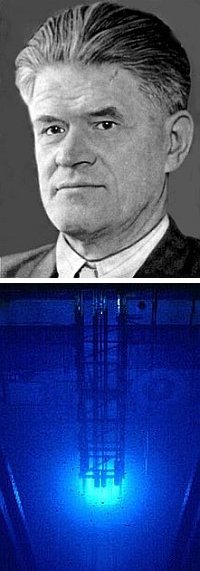 Cherenkov Radiation / Detector
Cherenkov Radiation / Detector

Cherenkov radiation (also spelled Cerenkov or Cherenkov) is electromagnetic radiation emitted when a charged particle (such as an electron) passes through a dielectric medium at a speed greater than the phase velocity of light in that medium. The charged particles polarize the molecules of that medium, which then turn back rapidly to their ground state, emitting radiation in the process. The characteristic blue glow of nuclear reactors is due to Cherenkov radiation.
It is named after Pavel Alekseyevich Cherenkov (1904-1990), a Soviet physicist who shared the Nobel Prize in physics in 1958 with Ilya Frank and Igor Tamm for the discovery of such new effect. In 1934, while working under supervision of S.I. Vavilov, Cherenkov observed the emission of blue light from a bottle of water subjected to radioactive bombardment. This phenomenon, associated with charged atomic particles moving at velocities greater than the speed of light in the local medium, proved to be of great importance in subsequent experimental work in nuclear physics, and for the study of cosmic rays. He was the first to characterise it rigorously.
After the discovery, several scientists developed Cherenkov detectors to help them in the study of cosmic rays. Basically, a Cherenkov detector is a particle detector using the mass-dependent threshold energy of Cherenkov radiation. This allows a discrimination between a lighter particle (which does radiate) and a heavier particle (which does not radiate). It is a more advanced form of scintillation counter.
A particle passing through a material at a velocity greater than that at which light can travel through the material emits light. This is similar to the production of a sonic boom when an airplane is traveling through the air faster than sound waves can move through the air. This light is emitted in a cone about the direction in which the particle is moving.
Cherenkov detectors are key part of modern particle detectors flown on stratospheric balloons. Even a few instruments are entirely based on the detection of this radiation as was the case of the High Energy Gamma Ray Gas Cerenkov Telescope developed and flown by the Laboratory of Nuclear Studies at Cornell University in late 60's.

